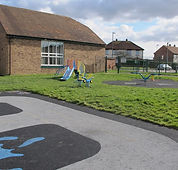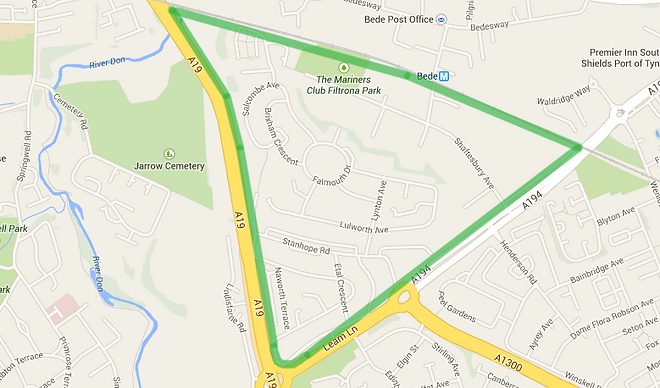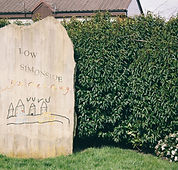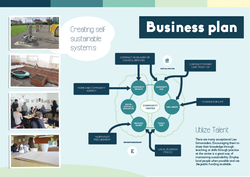LOW SIMONSIDE COMMUNITY CENTRE PROJECT
Low Simonside was a great project; it marked the development of the cohort taking leadership with minimal input from the tutors. After learning some important lessons from the Centre for Life, I was ready to give 110% from the beginning of this project. The project began with a little background about the centre, and the changes they are going through. Low Simonside Community Centre is located in Jarrow about 20 minutes away from the Northern Design Centre. This project did not have a brief, we were informed that the community centre is changing from being council funded to becoming publicly funded and run. As a cohort we were tasked to create our own brief based on where we believed we could add value. The most important aspect of this project was to really get to know the locals and the area to truly uncover where the benefits and threats lie. From the outset we took control collectively and organized ourselves into appropriate teams to get the most out of the taskforce we had.
 AROUND THE COMMUNITY CENTRE |  TALKING TO THE COMMUNITY |  ENJOYING THE SUN |
|---|---|---|
 OUTDOOR FACILITIES |  EXTERIOR OF CENTRE |  THE TEAM |
 TALKING TO CENTRE USERS |  INSIDE LOW SIMONSIDE |  SIGNAGE |
 CONDITIONS OF USE |

WEEK ONE: VISIT TO THE CENTRE, RESEARCH AND COFFEE MORNING
We began on Monday 3rd of March with the briefing and background, and later on that day in the limited time left we started to organise ourselves, and decided to meet early the next morning to visit the centre. Laura was appointed as the main correspondence between the Centre staff and MDI, Catie for the Tutors and Francis with the main client Ross. We decided to ensure everything ran smoothly it might be easier to elect a project manager. Craig put himself forward to be project manager for the two weeks to monitor what each group was doing and to ensure there was communication between all groups. On Tuesday we identified the main areas we needed to explore around the community centre and the main questions we needed to ask the community. The community itself is enclosed in the sense there is only one road in and out of it. There are plenty of buses running through and a metro stop nearby. There is also a Tesco’s located 5-minute walk away from the community. Low Simonside is quite a large community space but the centre is not ‘central’ to the area. Luckily for us our tutor John Kearvell was actually a resident of Low Simonside and lived extremely close to the centre, he gave us a bit of insider insight to the area. We split up over 4 cars and had a cohort convoy over to Jarrow.

Map of Low Simonside Community Area
The community centre’s exterior was a little dated, and the signage was unclear and confusing. We were informed it used to be a school but was converted into the community centre. On arrival in reception we were greeted by Dawn, an extremely friendly staff member who had worked there for a while. She showed us around the centre, explaining all the facilities on offer. One of the groups that use the centre was having an art activity session whilst we were exploring inside the centre. The group was U3A, the University for the Third Age. They gave us some really key insights as to how important the community centre was to them. I discovered the activities list and immediately it jumped out at me that the list was confusing and unclear, there are a wide variety of activities on offer but after speaking with Dawn, she explained that many of them have a low attendance. During our initial visit a few other surrounding community centres were mentioned Perth Green, so we ensured we had a follow-up group visiting those other centres to find out more about what keeps the place busy. Our team visited the East side of the centre where the Tescos and other big shops were. It seemed these shops serviced a much wider community so it did feel very separate to Low Simonside itself. After a few hours all the groups had rejoined back at the community centre, we went back to NDC for compare findings. Craig acted as scribe and collated all the findings of each group on one of the walls so we could identify the main issues. Quite a few common trends arose, many people who don’t use the community centre feel that it is for the older generations and believe there are no classes running appropriate for them. Unless you go into the community centre there is no information out with the centre, and the Facebook page is not properly set up.
After all the information was recorded we then discussed how many teams we needed and what their focus would be. I suggested there should be a team to define the real problems and get to the bottom of the issues at the CC. We also needed a team doing desk-based research and case studies on successful publicly run CC. There was then another three groups formed, business strategy, storytelling and communication; and finally my group creative ideation. These teams were not set in stone, but just as a guide of what to work around.
Field Trip on Tuesday to Low Simonside
 |  |
|---|---|
 |  |
 |  |
 |  |
 |  |
 |  |
On Wednesday we were informed that a coffee morning was being organized on our behalf for the Friday to have the opportunity to speak to more locals. Max and Lewis got onto the flyer design and distribution to ensure we had the maximum turnout. Laura, Valeria and myself began brainstorming about how we could engage this audience for the coffee morning and get a good quality of information from them. As I have held focus groups before I suggested using the World Café gamestorming technique. This involves small groups of people discussing a specific topic area for 15 minutes or so and using the tablecloth to write everything down. Valeria showed us a book she has used before called ‘Gamestorming’ which also had the same technique in with the book. So the three of us decided to start developing the questions we might ask and a materials list for Friday. I suggested we have someone create a ethics form for the attendees of the coffee morning, Craig completed and printed them. In discussing what questions to ask I suggested we keep the questions quite open which would mean the responses would not be limited. Some of our initial question ideas were:
How can people be made more aware of the CC facilities?
What do you feel is missing from your community?
What is the best moment of the year at the CC?
What do you expect from your community?
When do you like to go to the CC?
What do you love about Simonside?
What is your idea of a perfect community centre?
The following day we had a cohort meeting with Nick to discuss our plans for the coffee morning and how to get the most out of it; so our team decided to not make any final decisions until after our meeting. At the meeting I explained to everyone what our group had planned for Friday. Nick then suggested we do the exercise ourselves around how we could make the morning more interesting than just asking and answering questions. By the end we had selected 7 focal questions to ask on the day:
What aspects do you like/dislike about your community centre? (love hate scale)
Memorable community moments (calendar to plot)
What do you expect from your community centre? (swot plot)
What is missing from Low Simonside?
The prefect community centre would be…
Who is your community role model?
What do you do in your free time?
Valeria and myself then went to collect supplies for the following day, Sam and Max helped us draw up some of the questions and layouts for the following day. We decided only a few of us should go to the coffee morning as it was not necessary to have 20 people there. Laura, Valeria and myself felt as we had organized the plan of the morning we should attend, in addition there was Francis, Catie, Craig and Ashlee.
As the coffee morning began at 10, I wanted to get there for 9am so we had time to set up and make sure we had all the tables and chairs we needed. We were using their main function room located next to the café. Ross had kindly organized for free tea, coffee and cake for all involved as a small incentive for people to come along. The turnout from 10am-12pm was lower than we had hoped but we still had multiple valuable conversations. There was a steady stream of people throughout the 2 hours, unfortunately it did not go exactly how I had hoped with people having group discussions, but we designed the coffee morning to be flexible so as not to limit our response. Personally I spoke to about 7-8 people, some of which were part of the committee for the community centre which was extremely helpful. I felt this morning helped us gather a huge amount of data and we left the posters up over the weekend as well for people to answer in their own time. We decided to bring some of the posters back to NDC and we discussed our findings with the rest of the cohort on returning. There were some trends beginning to emerge, but we wanted to wait until Monday when all the data was collected before we decided our next steps.
PICTURES FROM COFFEE MORNING
 |  |  |
|---|---|---|
 |  |  |
 |  |  |
 |  |  |
 |

WEEK TWO: DEVELOPING A NEW LOW SIMONSIDE
We regrouped at the beginning of the second week to decide on what our next steps were. Our main findings of what the community was missing were:
Centre that attracts all ages
A licensed bar
Accessibility (to the facilities and timetables)
Job Opportunities (additional learning and help for unemployed residence)
With our project only being two weeks I wanted to ensure our deliverables brought the maximum amount of value for the community centre as possible. We had some very lengthy discussions on the Monday and Tuesday about ideas, directions and communications. I suggested that we design different deliverables depending on what the final data is, so booklets or boards, whichever was more appropriate. As a cohort we discussed selecting a few of our ideas to take forward. On Tuesday we had an idea generation day; we all sat down with sheets of A5 and wrote out or sketched an idea we had thought of that could improve the community centre and add value. I had a few ideas, mine included a charity shop set up inside the centre, with donations received and sold from one of the unused rooms. Another was to have notice boards dotted around the community, with regular updates as to what is on at the CC. After collecting in over 80 ideas, we decided to all stand up individually and talk through them, then vote on our favourite ideas. After extensive discussions, I suggested that we be inclusive of all ideas, and create a book with all of them in. Max and myself then began to develop the ‘inspiration pack’ (Max’s name). We came up with a rating system for each idea based on things like cost, resources, age, demand, space needed, time, etc. Max photographed all the ideas and re-drew out some of the more wordy sheets. I began compiling the InDesign Inspiration Pack; Laura helped me create a little description for each idea. The thought behind creating this pack was to hand over to the community and they can have a look through and potentially implement some of the ideas they like. We added some background about the coffee morning within the book and some of our findings, the book was over 150 pages long packed with ideas by the end.
An issue we did identify was if you would like to hire any of the spaces or set up a new activity it was quite a complicated procedure. Sam and Valeria created the service toolkit, which was an easier service design to how they should run the hire of the spaces; this document complimented ours very well. The content was discussed heavily between us all, trying to uncover the most valuable things to design and present. Some others in the cohort created the brief and vision boards, background about our findings, community identity, business analysis, business plan and timeline.
 TEAM DISCUSSION |  PLANNING THE BOARDS |  FINDINGS AND IDEAS |
|---|---|---|
 DECIDING DELIVERABLES |  PLANNING INSPIRATION PACK |  FINAL PRESENTATION |
 FINAL PRESENTATION |  FINAL PRESENTATION |  ANY QUESTIONS? |
On Thursday we had a practice presentation with Nick and Mark, as most of the work was not polished we had not had time to practice our presentation line up. I took the floor and presented a large portion of the work. Francis and Catie both spoke about the business sustainability plan they had created. Overall, although we seemed unprepared this was very helpful for us to do, as it allowed some last minute tweaking to the work we had created. We had planned to print off all the work but as we had not had the opportunity we showed the lecturers everything digitally. The core team had a fairly late night on Thursday although I finished my inspiration pack in good time; there were still bits of work that needed to be completed.
The following day Max and Sam went to the printers and the rest of us met at NDC for practice a run-through. At first we were only going to show the printed work, but I thought it would be easier for presentation reasons, if we projected the work as well; so myself and Alain knocked up a quick PDF with the boards and some pages from the booklets. The presentation was not until 2pm so we had plenty of time to practice; myself, Catie, Francis, Luke and Sam presented that day. I also helped Catie reword and cut down her part as she was focusing too heavily on business jargon, which I believe she found very helpful. We presented to Ross our main client and Nigel who was heavily involved with the Centre’s asset transfer. I thoroughly enjoyed the presentation, as we practiced multiple times, we came across as very professional and all the points we wanted to make were made. The client was very impressed with all of the work, and really liked the inspiration book, which I was happy about. We had a lengthy question and answer session following the presentation, Ross mentioned how our presence at the centre had created a bit of a buzz and people are getting excited for change. I hope long term the work we have done makes a difference and has inspired some of the locals to take back ownership of their community centre.
I felt this project was the first big step to independence as a cohort, what really worked was our structure, with various individuals acting as a point of contact for the client, the tutors and the community centre staff and Craig Fenby as our first Project manager; we managed and organized our time over the 2 weeks very effectively. As a cohort I believe many of us found this the most rewarding and successful project so far.
FINAL BOOKLETS
FINAL PRESENTATION BOARDS
 |  |  |
|---|---|---|
 |  |
INSPIRATION PACK SAMPLE
The inspiration pack I created is too big to be uploaded here, but here are some stills from inside the booklet.
 |  |  |
|---|---|---|
 |  |